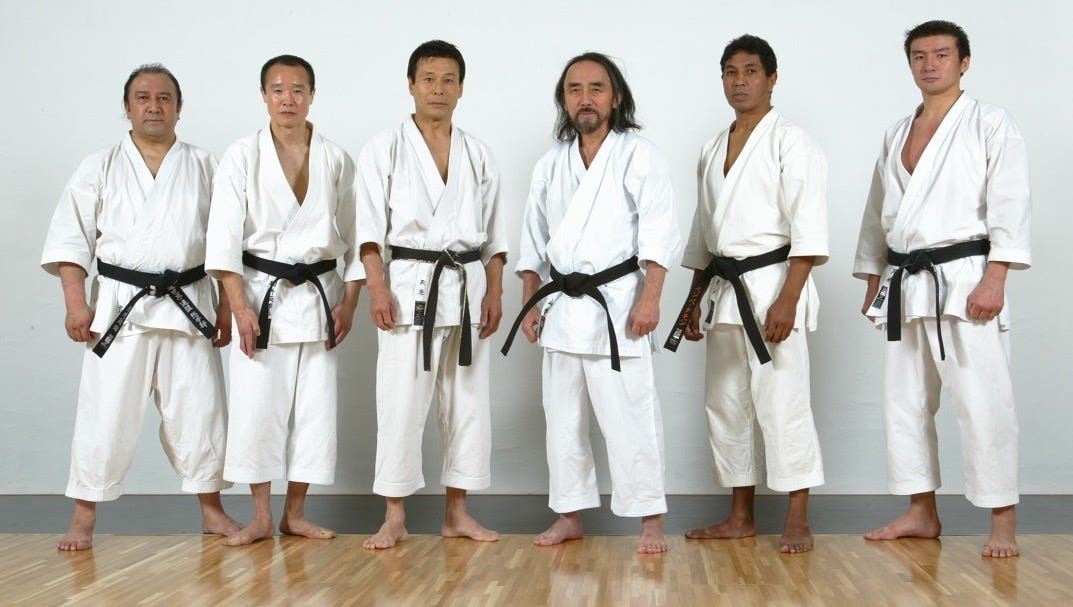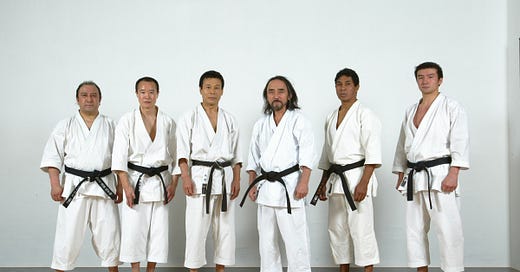What Makes Oi Zuki the Soul of Karate Training?
Uncover the hidden beauty and power of Karate's core principles within this essential technique. A deep dive into Kihon, mastery, and martial heritage.
Oi Zuki is a great and beautiful technique.
And it’s also one of the most misunderstood one, and even by Karate-ka themselves!
“Karate is not effective, you cannot use Oi Zuki or such low stances in real fight!”
Such statements can only be made by someone who has never truly practiced or even understood what traditional martial arts are and the beauty behind their legacy.
Of course Oi Zuki is not intended to be used as is in a fight or self-defense situation.
But Oi Zuki contains all the keys and principles that can make you master more advanced techniques and strategies designed for that.
This is the beauty of the traditional Japanese spirit: taking something, studying it, practicing it, mastering it, refining it and transforming it into an art, a way of being.
And Karate is no exception to the rule.
In order to be able to master something, Japanese culture tends to simplify it as much as possible, to remove all uncertainty, everything that is unnecessary to understand its heart, its principles and its intrinsic beauty. So that you can practice it more easily, more freely, and touch, then master its core principles.
That’s why Karate may seem very academic to many, because for learning purposes it has been broken down, structured and ordered with the ultimate aim of improving its teaching and understanding.
You may not agree with this way of doing things, but if you look at the Japanese objectively, they are always able to achieve a world-class level in all areas, by observing, learning, rehearsing and polishing whatever they appropriate.
When I was in Japan for my first trip over there, during the first three months, Yahara Sensei and the other masters of KWF Hombu Dōjō (I spent a full year training there in Tokyo) basically only taught me Oi Zuki. Of course I was practicing other techniques, but they only cared about the way I was moving forward to punch. And during and after class, they only corrected me on this technique! At that time I didn’t fully understand this, but I was trusting them, so I was relentlessly repeating my Oi Zuki in front of the mirror every day after class.

And guess what?
This allowed me to feel for the first time the sensation that I talked about in a previous article and which relies on the “Shin Gi Tai” (心技体 - Spirit/Heart - Technique - Body) concept I explained there:
This is what Kihon (基本 - basic training) are made for, polishing the techniques so that we can one day feel the right way to do them. And when you feel it once, you know. Then the rest of your training becomes trying to get that feeling back, and more and more often.
It’s interesting to note that before its development in mainland Japan, it seems that there were not such kind of Kihon training, and the practice was mainly based on the Kata (型 - forms), which - due to their complexity - required very long period of training and dedication to master the basics. Learning process was made easier by the use of the decomposing approach of Kihon - inspired from Kendo (剣道), the way of the sword.
And in this field, Takushoku University in Tokyo, under the great leadership of Tsuyama Katsunori Shihan was truly the best. His unique training approach, based on the in-depth study and practice of fundamental principles of techniques, has produced most of today’s famous JKA (Japan Karate Association) competitors and instructors. Of course, the training there was indeed very (very!) tough, but like in many other universities, and the highly analytical approach of Kihon taught by Tsuyama Shihan really made the difference.
Today too, even though I think I have a deeper understanding about this technique and the Karate core principles, every time I meet my Sensei, Tamang Pemba Shihan, he carefully looks at my Oi Zuki and inevitably says “No satisfaction…”. And then he spends hours teaching me how to master this simple technique.
That’s why one of my mottos has always been “Master Simple Things, Keep a Clear Direction”.
And for the anecdote, I remember that for its 8th Dan test, Yahara Shihan, the famous KWF Chief Instructor, performed Heian Shodan! (which is the first and most basic Shotokan Kata)
Beauty lies in simplicity. And so is mastery.
I believe that the spirit of Karate practiced as a Budō (武道 - Martial Ways) is all contained in Oi Zuki, and especially the spirit of Shotokan (松濤館) which can be summarized by the maxim “ikken hissatsu” (一拳必殺) which roughly means “One killing blow”. Indeed, Oi Zuki contains the simplest expression of the main principle we aim for in Shotokan which is to convey all our power forward, with maximum speed and efficiency. And I will add, as my Sensei used to teach - which is one of the most important things, always done but not so often taugth by Japanese Karate-ka -, “smoothly, with the best possible trajectory and without unwanted movements”.
Bruce Lee would have said “Be water my friend!”.
OSS 🙏
Nicolas
📌 Reminder
Don’t forget our next live online seminar! 🔥🌍
This not to be missed class is opened to all paying members of any level and we will focus on the basic principles for generating speed and power, always keeping in mind that our Karate has to be effective! 👊
I can't wait to see you there!
🎁 And only ONE DAY LEFT for our special COMMUNITY GIVEAWAY!!!
So, if you want to experience free training with us, read this article and be one of the 20 lucky free subscribers who will win their 15 DAYS of Premium membership! 🎉
🔥 Want to achieve great Karate kicks and improve your flexibility & core power ? Check this out! 👇👇👇
Next steps
👊 Not a member yet? Take a look at the Membership page to find out what you're missing and join us!
❤️ Drop a like to this post to support our community
🤔 Questions or thoughts? Leave them as a comment below the article or by replying to this email!
♻️ Press the "Restack" button to share this article and inspire the next person on their path!
💬 Join the Chat for inspiring discussions with people who share the same vision of martial arts








